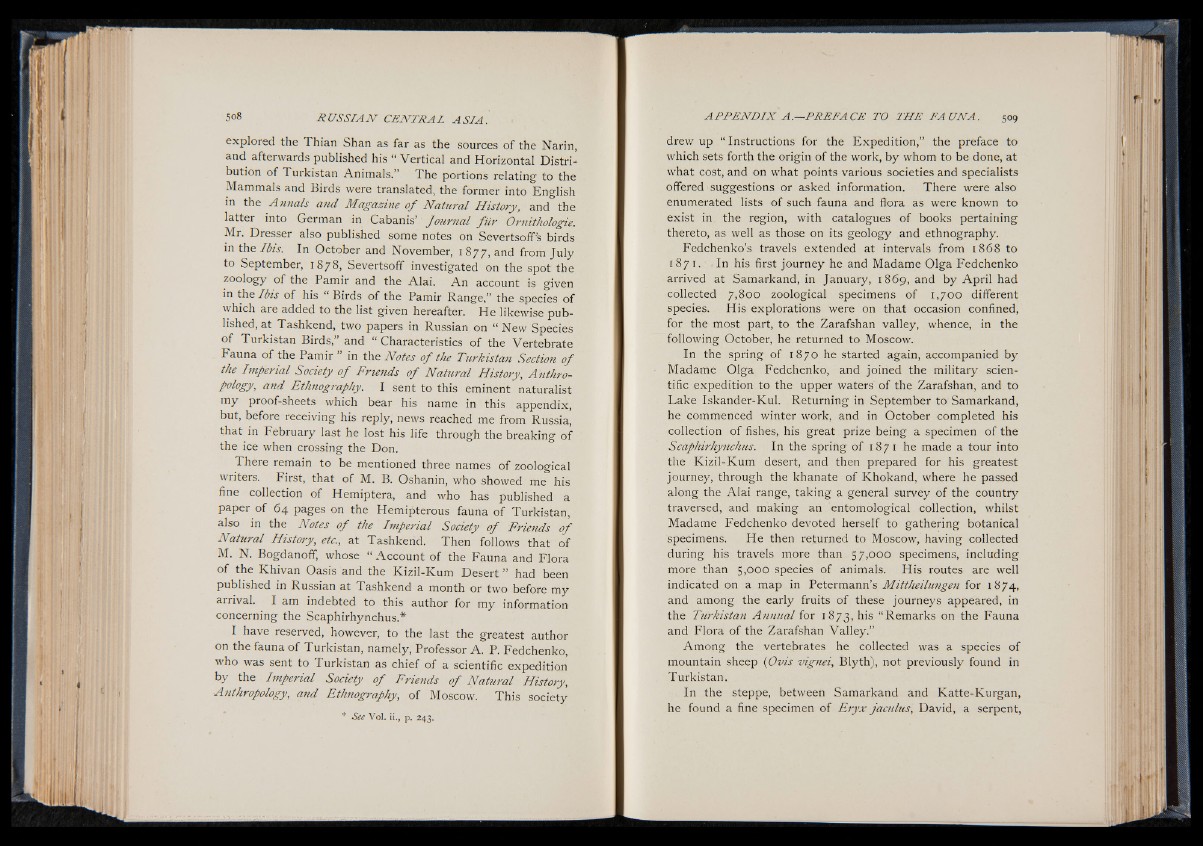
explored the Thian Shan as far as the sources of the Narin,
and afterwards published his “ Vertical and Horizontal Distri-
bution of Turkistan Animals.” The portions relating to the
Mammals and Birds were translated, the former into English
in the Annals and Magazine o f Natural History, and the
latter into German in Cabanis’ Journal fu r Ornithologie.
Mr. Dresser also published some notes on Severtsoff's birds
in the Ibis. In October and November, 1877, and from July
to September, 1878, Severtsoff investigated on the spot the
zoology of the Pamir and the Alai. An account is given
in the Ibis of his “ Birds of the Pamir Range,” the species of
which are added to the list given hereafter. He likewise published,
at Tashkend, two papers in Russian on “ New Species
Turkistan Birds, and “ Characteristics of the Vertebrate
Fauna of the Pamir ” in the Notes o f the Turkistan Section o f
the Imperial Society o f Friends o f Natural History, Anthropology,
and Ethnography. I sent to this eminent naturalist
my proof-sheets which bear his name in this appendix,
but, before receiving his reply, news reached me from Russia,
that in February last he lost his life through the breaking of
the ice when crossing the Don.
There remain to be mentioned three names of zoological
writers. First, that of M. B. Oshanin, who showed me his
fine collection of Hemiptera, and who has published a
paper of 64 pages on the Hemipterous fauna of Turkistan,
also in the Notes o f the Imperial Society o f Friends o f
Natural History, etc., at Tashkend. Then follows that of
M. N. Bogdanoff, whose “ Account of the Fauna and Flora
of the Khivan Oasis and the Kizil-Kum Desert ” had been
published in Russian at Tashkend a month or two before my
arrival. I am indebted to this author for my information
concerning the Scaphirhynchus.*
I have reserved, however, to the last the greatest author
on the fauna of Turkistan, namely, Professor A. P. Fedchenko,
who was sent to Turkistan as chief of a scientific expedition
by the Imperial Society o f Friends o f Natural History,
Anthropology, and Ethnography, of Moscow. This society
drew up “ Instructions for the Expedition,” the preface to
which sets forth the origin of the work, by whom to be done, at
what cost, and on what points various societies and specialists
offered suggestions or asked information. There were also
enumerated lists of such fauna and flora as were known to
exist in the region, with catalogues of books pertaining
thereto, as well as those on its geology and ethnography.
Fedchenko’s travels extended at intervals from 1868 to
1871. In his first journey he and Madame Olga Fedchenko
arrived at Samarkand, in January, 1869, and by April had
collected 7,800 zoological specimens of 1,700 different
species. His explorations were on that occasion confined,
for the most part, to the Zarafshan valley, whence, in the
following October, he returned to Moscow.
In the spring of 1870 he started again, accompanied by
Madame Olga Fedchenko, and joined the military scientific
expedition to the upper waters of the Zarafshan, and to
Lake Iskander-Kul. Returning in September to Samarkand,
he commenced winter work, and in October completed his
collection of fishes, his great prize being a specimen of the
Scaphirhynchus. In the spring of 1871 he made a tour into
the Kizil-Kum desert, and then prepared for his greatest
journey, through the khanate of Khokand, where he passed
along the Alai range, taking a general survey of the country
traversed, and making an entomological collection, whilst
Madame Fedchenko devoted herself to gathering botanical
specimens. He then returned to Moscow, having collected
during his travels more than 57,000 specimens, including
more than 5,000 species of animals. His routes are well
indicated on a map in Petermann’s Mittheilungen for 1874,
and among the early fruits of these journeys appeared, in
the Turkistan Annual for 1873, h's “ Remarks on the Fauna
and Flora of the Zarafshan Valley.”
Among the vertebrates he collected was a species of
mountain sheep (Ovis vignei, Blyth), not previously found in
Turkistan.
In the steppe, between Samarkand and Katte-Kurgan,
he found a fine specimen of Eryx jaculus, David, a serpent,